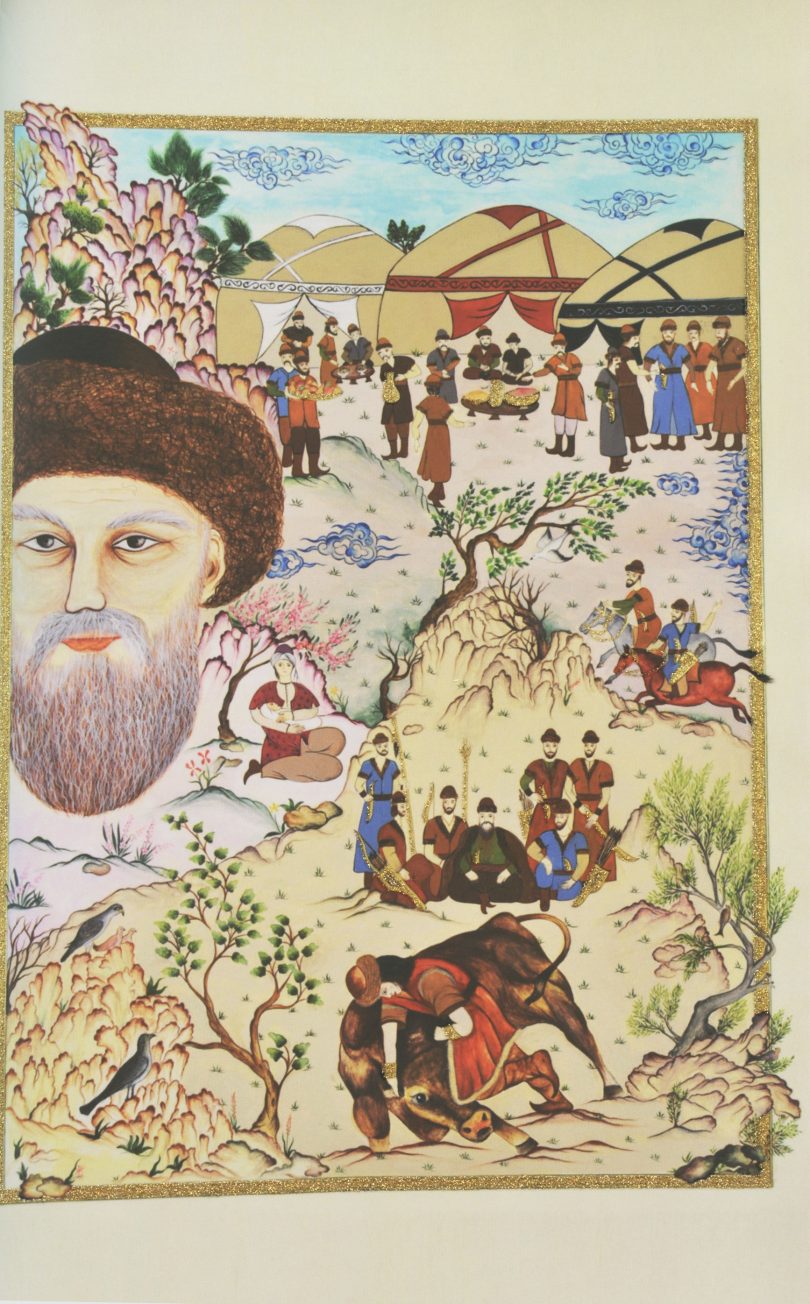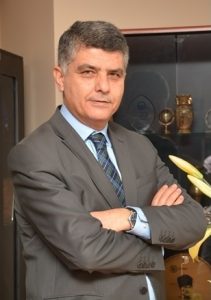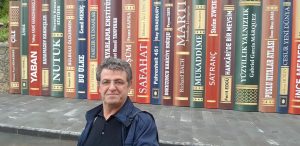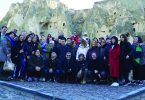TWO IMPORTANT DEVELOPMENTS OCCURRED LAST MONTH REGARDING OUR NATIONAL MEMORY, THE DEDE KORKUT SAGA. PROF. DR. METİN EKİCİ ANNOUNCED HAVING FOUND A CONTINUATION CORRESPONDING TO ONE STORY, WHILE PROF. DR. NECAT DEMİR DECLARED HIS DISCOVERY OF SEVEN NEW STORIES.
The Dede Korkut Saga, one of the most important inheritances of Turkish culture, consists of 12 narratives. The announcements made by two academics working in the field of the Turkish language, culture and ethnology during recent months point at the discovery of new texts of Dede Korkut. Prof. Dr. Metin Ekici announced at the World Cultural Heritage Dede Korkut International Symposium that he had found the 13th story, while Prof. Dr. Necati Demir announced on his social media account that he had found 7 new stories and additional texts. As Tr magazine, we spoke with Ekici and Demir, the protagonists of these two important news.
Prof. Dr. Metin Ekici: “A SOURCE FOR LANGUAGE, HISTORY AND PHILOSOPHY”
The discovery of a new copy of Dede Korkut was welcomed with great excitement. First of all I would like to ask this: why is Dede Korkut that important?
One of Turkish Literature’s foremost works, the Dede Korkut Book is a fundamental source for understanding the historical development of the Turkish language, grasping the artistic value of Turkish literature, observing the development pattern followed by Turkish culture, examining the Turkish history of thought, and knowing Turkish philosophy. Whether in Turkey or in the Turkic Republics or any other region in the world, a book on language, history and literature – art cannot be written without mentioning the Turkish language, literatüre and culture. When talking about the Turkish language and literature, the source that is most frequently referred to is the Dede Korkut Book. This is the reason why this new copy has been met with such great excitement in different countries, particularly in Turkey and by other Turkish tribes.
What is the meaning of the Dede Korkut saga for Turks as a literary texts?
The Dede Korkut Book must be seen not only as a linguistic and literary work, but also as a treasure of culture. Living in the World as a nation with an identity is only possible by understanding our past, and the lives of our ancestors accurately. And finding these truths is only possible by reading the correct sources accurately, and correctly understanding the messages given in those texts for today. What we are trying to emphasise here is that this is possible by not seeing the Dede Korkut Book as merely an adventure book, one in which the stories of the past are related, but by understanding its true value.
While everyone knows and learns the Homeric works the Iliad and the Odyssey, presented as the first works of world literature, the Dede Korkut Book, which contains an equally strong language and literature, must equally be known and learnt. The application we filed with UNESCO in 2016 thereon was deemed fit, and the book was included in the Representative List of the Intangible Cultural Heritage of Humanity as the joint heritage of Turkey, Azerbaijan and Kazakhstan under the name, “Dede Korkut – Korkut Ata Heritage: Culture, Legends and Music” as a result of the Intergovernmental Committee Meeting held in 2018.
Could you give us an example?
For instance, the Dede Korkut Book contains Turks’ colour aesthetics. A person is not directly reprimanded in society, but this reprimand is delivered over the symbolic meaning of colours within Turkish culture, even if this person is a Bey. In the legend “Story of Boğaç Khan, Son of Dirse Khan”, since Dirse Khan is childless, “he is entertained in a black tent, is given a black mat to sit on, and is served the meat of a black sheep”. The adjective “black” used in these actions point to a lacking in him, that is, his failure to achieve the unity of family is related through the use of the adjective “black”.
How did the process of discovering the 3rd copy of the Dede Korkut Stories develop, where did the research take place, where was it found?
In short, during our research in the Turkish world, our friends keeping the manuscript gave us a copy. I cannot reveal who this was, as I was not permitted to share this information. Presently I cannot provide any further information on this.
So, what differences are there between the 3rd copy and the Vatican and Dresden copies?
As it is known, the first copy of the Dede Korkut Book was discovered in 1815 in the German city of Dresden, where it is still kept, by the German librarian Fleischer, and was introduced to the scientific world in 1815 by H. Von Diez. This copy includes a preface and 12 sagas. The second copy was found in 1952 in the Vatican by the Italian Turkologist E. Rossi, and is still kept in the Vatican. This second copy includes a preface and six sagas. The manuscript we have contains a text of 61 pages. Each page of this manuscript contains a text of 14 lines written in ta’liq script and showing the linguistic characteristics of the Old Anatolian Turkish period. This manuscript contains the Korkut Ata / Dede Korkut genealogies, genealogies relating the qualities of the Oğuz heroes, and most importantly, the story “Salur Kazan Slaying the Seven-headed Dragon”, which is the 13th Dede Korkut Story or saga, which is not found in the other two copies.
What will we be able to learn from this story?
This narrative we have entitled “Salur Kazan Slaying the Sevenheaded Dragon”, which we consider the 13th of the Dede Korkut Stories, provides us with knowledge on Turks’ knowledge on supernatural beings, their approaches to warding them off, their ability to control nature, the courage of the Oğuz Beys, their faith in God, and how they overcome all difficulties and evil through this faith, while constituting an example in that it demonstrates how courage, prudence, intelligence, reliability and faith allows an Oğuz Bey to be accepted as a ruler. Again, in this narrative it is possible to see examples as to how the Oğuz or Turks view concepts such as fraternity, honesty and loyalty, as well as of their understanding of humour and comedy.
The Lost Narrative Of Kazan The Dragon-Slayer
I believe this is the first time a dragon figure is seen in a Turkish legend. Does this mean something? Is the fact that we encounter the dragon, which we usually see in Chinese mythology, merely ascribable to cultural interaction?
Encountering supernatural beings such as giants and dragons in Turkish legends and narratives such as myths, fairy tales and sagas does not amount to interaction, but is a reflection of the oldest Turkish cultural elements, Turks’ thoughts and imaginations on nature, on legends and similar folk narratives. While we encounter such a supernatural being in the form of a Cyclops in the other copies, the Cyclops narrative contains encounters with fairies. In fact, Salur Kazan introduces himself using the title “Kazan, Slayer of the Seven-headed Dragon” in the narrative entitled “The Pillaging of Salur Kazan’s House, and the Capture of his Son Uruz” contained in the other copies. This, in turn, brings us to the necessity of introducing this title used for Salur Kazan through a narrative, and the copy we discovered presents such a lost narrative.
Based on your research and experience, do you believe it would it be possible to discover an even older copy?
Making a definite guess on this matter would not be right at this point, but it is possible that other copies and an older copy may be found. The appearance of such works, which are important sources of our cultural history, literatüre and language, centuries after they were committed to writing gives us hope and joy. The discovery of the first two copies occurred two and four centuries after the 15th and 16th centuries, in which they are considered to have been written down. The fact that this copy appeared two centuries after the first copy may be considered as a sign indicating that other texts may be found. As a scholar wishing to serve the Turkish world, I work to illuminate our language, literature, art, culture and science world, and consider it a duty to share the data obtained from our research as a common wealth of our nation and the Turkish world. Setting off from this thought, I consider it fit to name this copy, which is a product of the Dede Korkut / Korkut Ata tradition, a joint cultural heritage of the Turkish world, and which has been accepted by UNESCO as an Intangible Cultural Heritage of Humanity, the “Turkestan” copy.
Prof. Dr. Necati Demir: “I COLLECTED 7 STORIES FROM AROUND THE WORLD”
There have been exciting new developments regarding the Dede Korkut Saga. What is it that makes Dede Korkut so special for us?
One of the most important sagas of the Oğuz Turks is without doubt the Dede Korkut Saga. Dede Korkut, also known as Korkut Ata, is a value of the deep memory of Turkishness. His proverbs and aphorisms, the legends told about him, sagas, poems are all products of the deep memory of this Turkishness.
What do we find on Turkish culture in this text?
The Dede Korkut Kitabı is without doubt the Oğuzname, or a part of the Oğuzname. Dede Korkut is the person who arranged and narrated the parts of that Oğuzname. That is, since Dede Korkut was the person who arranged and narrated the Oğuzname, certain parts of the Oğuzname became known as the Dede Korkut Stories, or the
Dede Korkut Saga. I believe that what makes this saga special and important is that it is a reflection, albeit fragmented, of the history of the Oğuz Turks. Indeed, part of the Dede Korkut stories concern events that occurred in the 9th-10th century in the vicinity of the Aral Sea – Mangyshlak. These centuries correspond to a period in which the historical records of the Oğuz Turks are the most sparse.
Previously our only knowledge on this period was based on the information provided by Arab travellers. The Dede Korkut stories are very important in that they provide information on this period. Another aspect of the work is that it provides information on the lifestyle and traditions of the Oğuz Turks. In this sense, it is a unique source.
Could you tell us something on the place the Dede Korkut Saga occupies in history?
Of course, we have no knowledge on the early form of the Dede Korkut Saga. However, it is not difficult to guess that it would resemble the form of the Oğuz Kağan Saga written in Uyghur letters. But the Dresden copy and the Vatican copy that we already have in our possession present the Dede Korkut Sagas in the form of employed by the folk storytelling of eastern Turkey and Azerbaijan. In other words, it is as if the Dede Korkut Saga was sung by a storyteller and put to paper by a skilful scribe. Indeed, the frequently used interjections “My Khan!”, “My Sultan” give the impression that they are exclamations recited to warn the audience and attract their attention.
The poetic and prose structure and style of the text resembles folk stories such as Kerem ile Aslı and Ferhat ile Şirin told by storytellers in eastern regions, in Azerbaijan and Iranian Azerbaijan. In fact, however, it is obvious in many places that it is part of the Oğuz Kağan Saga. The Dresden and Vatican copies of the Dede Korkut Saga are arranged as “boys” (stories). Some researchers thought that the word “boy” (story) used here meant “ethnic community, tribe”. However, here the word “boy” denotes “story, independent section”. In other words, each “boy” is a separate story, and does not concern an ethnic community.
How close to reality are these stories?
It is understood that many events that take place in the Dede Korkut Saga are tales. For instance, in the Saga of the Story of Kan Turalı, Son of Kanglı Koca, the struggle put up by Kan Turalı against a black bull, a black camel and a black lion to marry the daughter of the Lord of Trabzon has the feeling of a fairy tale. However, it is also known that many information and events are real. While the Komnenos brothers, who founded a state in Trabzon following the sack of Istanbul by the Crusaders in 1204, were referred to emperors by Western historians, Turkish historians thought differently. Of course, it is not accurate to refer to the ruler of a city state with a population of approximately five thousand as an emperor. In fact, the Dede Korkut Saga refers to the Komnenoi of Trabzon accurately as “tekür or tekfur”, that is, “head priest”.
You said that the Dede Korkut legend was among the Oğuzlamas. Could you be more specific?
Actually the Dede Korkut Saga are a continuation of the Oğuzname. As we said previously, Dede Korkut is the name of the man who compiled, arranged and recited these Oğuznames. While the work was a section in the Oğuzname, it came to be referred to as the Dede Korkut Saga since it was told by Dede Korkut. Therefore, it is not strange that we found the Dede Korkut Stories within the Oğuzname.
In your social media share you said that you found new stories. What do you have in your file?
Yes, I found 8 new texts that I may add to the Dede Korkut Saga. I conducted a very thorough research on Oğuzname in 2017. It was my desire that we should find out all there is to learn o the Oğuzname by scanning all of the libraries in the world. The result was a 10-volume book I wrote on Oğuzname. Part of it was published, and part awaits publication. Sections of the Dede Korkut Saga emerged from within various copies of the Oğuzname. I collected these, and they amounted to 8 sections. 7 of these may be considered stories. One is very short, and is included in a historical text. In short, we have 8 sections in our file, and 7 of these may be considered stories. One of them may be considered a contribution.
How long did your research take? Where did you go and what did you do?
Actually, I have been working on the Oğuzname for 30 years. I kept reading. Then I found that the sources were very disorderly. In 2016 I decided to compile them all. I had already collected most of the copies. In 2017 I started a new search, seeing if I could find anything else in the world. Within this scope, I personally went and scanned the libraries in Germany, France, Britain, Russia, Uzbekistan, Azerbaijan, Austria, Mongolia and India. I scanned the libraries of other countries either via the Internet, or a asked my friends for help. I did not know if anything new would come up. I prepared all that I had collected for publication. As I said above, complements to the Dede Korkut Saga emerged from this study.
In addition to the texts, there are tombs that you discovered. Which ones are these?
Yes, in the meanwhile I was writing on the Conquest of Turkey and the Danishmend State. I made many discoveries while working on that. One of these was the tomb or grave of Dede Korkut. The other was the tomb of Bayındır Khan, Khan of Khans… The tombs are in Ahlat…
Considering the location of these tombs, what should we infer?
The location of the tombs is in fact Ahlat, the first cultural environment of Turks in Anatolia. It served as the base for the conquest of Anatolia. I believe that Dede Korkut composed his stories in Ahlat. It is very natural that the tombs of Bayındır Khan and Dede Korkut are located in Ahlat. In fact, the tombs tell us a lot. Looking at this, we should reconsider and research Ahlat’s place in Turkish history. As for the public, this matter has not yet been fully understood by intellectuals. Under these circumstances, it is not really possible for the public to understand it.











Leave a Comment